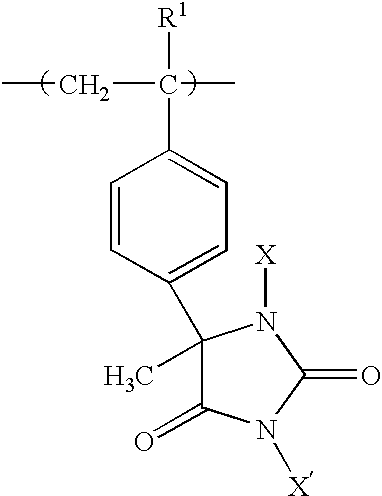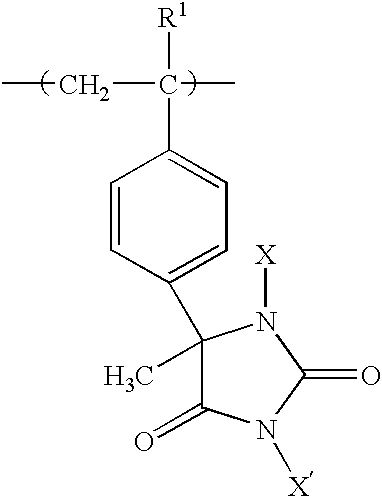Biocidal polystyrene hydantoin particles
a technology of polystyrene hydantoin and biocidal polystyrene, which is applied in the direction of biocide, synthetic polymeric active ingredients, sanitary towels, etc., can solve the problems of slowing down the flow rate and the concern of workers handling materials, and achieve the effect of preventing or minimizing noxious odors
- Summary
- Abstract
- Description
- Claims
- Application Information
AI Technical Summary
Benefits of technology
Problems solved by technology
Method used
Image
Examples
example 1
Preparation of Chlorinated Beads at Maximum Chlorine Loading
Porous beads of 5.6% crosslinked polystyrene obtained from Suqing Group (Jiangyin, Jiangsu, PRC) having particle sizes in the range 250 to 600 μm and pore sizes of about 50 nm were cleaned by soaking in acetone for 2 hours at 25° C. and passing 2 portions of acetone through the beads in a filter funnel. Following drying to constant weight in air at 25° C., 50 g of the beads were suspended in 300 mL of carbon disulfide in a 500 mL flask and allowed to swell for 15 minutes. Then 128.2 g of anhydrous aluminum chloride were added, and the mixture was stirred for 15 minutes at 25° C. While continuously stirring, a mixture of 59 g of acetyl chloride and 50 mL of carbon disulfide was slowly added to the flask from a dropping funnel over a period of 2 hours with the temperature being held at 25° C. The mixture was refluxed for a period of 2 hours. The product of the reaction was poly-4-vinylacetophenone porous beads. Purification s...
example 2
Biocidal Efficacies of Chlorinated Beads at Maximum Chlorine Loading
The beads as prepared in Example 1 were tested for biocidal activity against several pathogens contained in water. In one test, about 3.9 g of chlorinated beads were packed into a glass column having inside diameter 1.3 cm to a length of about 7.6 cm; the empty bed volume was 3.3 mL. An identical sample column of unchlorinated beads was prepared to be used as a control. After washing the column with demand-free water until less than 0.2 mg / L of free chlorine could be detected in the effluent, an aqueous solution of 50 mL of pH 7.0 phosphate-buffered, demand-free water containing 6.9×106 CFU (colony forming units) / mL of the Gram positive bacterium Staphylococcus aureus (ATCC 6538) was pumped through the column at a measured flow rate of about 3.0 mL / second. The effluent was quenched with 0.02 N sodium thiosulfate before plating. All of the bacteria were inactivated in one pass through the column, i.e., a 6.9 log redu...
example 3
Preparation and Biocidal Efficacy Testing of Brominated Beads
5.0 g of poly-5-methyl-5-(4′-vinylphenyl)hydantoin porous beads prepared as described in Example 1 were suspended in a flask containing 50 mL of 2 N NaOH. While stirring the suspension, 10.0 g of liquid bromine were added dropwise at 25° C. over a period of 10 minutes. The pH was adjusted to 6.4 by the addition of 4 N acetic acid, and the mixture was stirred at 25° C. without the further addition of bromine for 1 hour. The brominated beads were then filtered and washed 5 times with 100 mL portions of tap water and dried in air at 25° C. for 8 hours. An iodometric / thiosulfate titration indicated that the beads contained a 36.8 percent loading of bromine by weight. An infrared spectrum of a small sample of the beads (crushed to a powder) in a KBr pellet exhibited prominent bands at 1724 and 1779 cm−1 in good agreement with that of powdered poly-1,3-dibromo-5-methyl-5-(4′-vinylphenyl)hydantoin prepared earlier starting from s...
PUM
| Property | Measurement | Unit |
|---|---|---|
| temperatures | aaaaa | aaaaa |
| weight | aaaaa | aaaaa |
| total weight | aaaaa | aaaaa |
Abstract
Description
Claims
Application Information
 Login to View More
Login to View More - R&D
- Intellectual Property
- Life Sciences
- Materials
- Tech Scout
- Unparalleled Data Quality
- Higher Quality Content
- 60% Fewer Hallucinations
Browse by: Latest US Patents, China's latest patents, Technical Efficacy Thesaurus, Application Domain, Technology Topic, Popular Technical Reports.
© 2025 PatSnap. All rights reserved.Legal|Privacy policy|Modern Slavery Act Transparency Statement|Sitemap|About US| Contact US: help@patsnap.com



